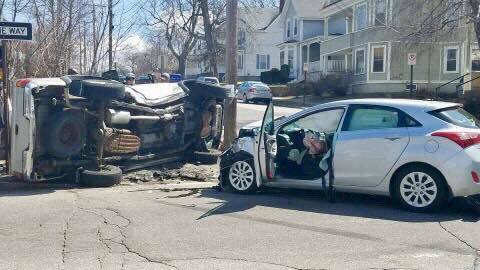
Residents and neighborhood stakeholders gathered at the Currier Museum of Art on April 11 and again on April 18 to discuss the safety issues posed by the one-way, two-lane “neighborhood highways” that are Beech and Maple streets.
(Media coverage of the April 11 meeting was provided by both WMUR and the Union Leader. And you can read more about the April 18 meeting in this Union Leader article.)
As if to underscore the need to make these streets safer, less than an hour after the first meeting on April 11, there was yet another collision, this time at the intersection of Maple and Blodget streets in which a truck was hit with such impact it was knocked on its side and up on the sidewalk:

Indeed, by my count, in the past three weeks there have been four incapacitating crashes on Beech and Maple streets, just between Bridge and Webster.
While going door-to-door during my campaign for alderman last year, the number one complaint I heard from the residents of the western third of Ward 2 was that of speeding. “Manchester Motor Speedway” is how many refer to Beech and Maple streets. And living only a few blocks from Maple myself, and having traveled both Maple and Beech daily for more than 10 years, I know they aren’t exaggerating.
That said, in my campaign I also made a point of saying that I am a proponent of data-driven decision making. So once in office, I began gathering data with regard to the conditions on Beech and Maple. And the data I’ve analyzed thus far is concerning to say the least.
In my research I discovered that one-way streets disproportionately contribute to motor vehicle deaths in Manchester. Indeed, one is nine times more likely to die on a one-way street in Manchester than on a two-way street.
According to data from the NH DOT Crash Database, during the 10-year period spanning 2006-2015, Manchester saw 31 people die in motor vehicle crashes on city streets. 29 percent died as a result of crashes that occurred at intersections that contain at least one one-way street. One-way streets, by the way, comprise only 4 percent of city streets. This is a one-way street death rate of 1 death per 1.9 miles.
For comparison purposes, this is nine times greater than the city’s two-way street death rate, which is 1 death per 17.8 miles.
While these are just a few data points, I think they demonstrate that these neighborhood highways must be made safer. We cannot in good conscience allow them to remain as they are.
To this end, at the May 1 meeting of the Board of Mayor and Aldermen’s Committee on Public Safety, Health, and Traffic I will introduce a motion to request the City’s Department of Public Works, in conjunction with relevant other City departments, begin collecting and analyzing more data as a means to proposing data-driven solutions that will result in safer streets and safer neighborhoods for residents and all who use these streets, be they drivers, pedestrians, or bicyclists.
This will not be accomplished overnight. As such, I’d like to thank the Manchester Police Department for their efforts in helping to address this issue with increased speed enforcement and the recent placement of radar trailers on Beech and Maple. Enforcement alone can’t solve this problem as police officers can’t be every all the time, but every little bit does help.
Have ideas on how Maple and Beech can be made safer? Email me at wstewart (at) manchesternh (dot) gov.
Kevin says:
Will , I feel that we need (three phase traffic signals at beach & north -Sagamore & maple as well as beach and salmon.
The intersection @ Beach & north is a school bus stop during the am commute making it a higher priority ,whereas beach & salmon With limited visibility due to the sidewalk plantings and parking; combined with the high rate of speed on Beech , becomes a treacherous and very dangerous intersection.
At beach & North it becomes a major thoroughfare for everybody who lives up on the hill coming from the east.
Considering the high rate of acceleration that begins at Webster the reaction time for those traveling across Beech and Salmon is just not enough to navigate these intersections do to the Speed, Blind spots/ Narrow field of vision to oncoming traffic.
The busy seasons is nearly upon us and the speeders will be flying down these two major OneWay streets and cross streets.
I believe it’s just a matter of time before we have one or more Fatalities here in or neighborhood.
Thanks for the research and attention you have given to this long overdue issue.
Sincerely: Kevin Clancy
860/862 Beech St
Ginny Theo-Steelman says:
Will,
What would be the pros & cons of considering reversing both streets to 2 way?
In your “neutrality” currently on the issue, is there a compilation of suggestions?
Alderman Will Stewart says:
I am asking the DPW to propose solutions after looking at more data, and to identify pros and cons for each possible solution, including a reversion to two-way traffic.
Other possible solutions mentioned thus far include keeping the streets one-way, but going down to one lane and adding an additional parking lane. Additional solutions that have been suggested include greater speed enforcement, better/more signage, and making the intersections safer via the trimming of bushes and other visual impediments.